Climate chief calls for Mass Save changes
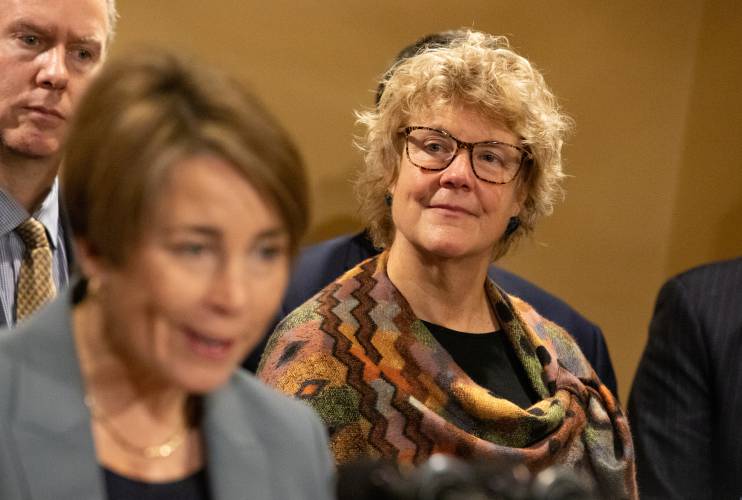
Climate Chief Melissa Hoffer watches Gov. Maura Healey at a press conference. According to Hoffer’s recent report, Massachusetts’ efforts to meet its net zero goals and measure up to neighboring states may mean an overhaul of energy efficiency program Mass Save. STATE HOUSE NEWS SERVICE
| Published: 11-12-2023 3:31 PM |
Massachusetts’ efforts to meet its net-zero goals and measure up to neighboring states may mean an overhaul of energy efficiency program Mass Save, according to Climate Chief Melissa Hoffer’s recent report.
The state’s Clean Energy and Climate Plan outlines what Massachusetts must do to achieve “net zero” greenhouse gas emissions by 2050.
Published Oct. 25, the “Recommendations of the Climate Chief” states that Mass Save must be reformed if the program is to “maintain its key role” in Massachusetts’ decarbonization efforts.
“It has become increasingly clear, particularly in light of the successes of sister-state entities Efficiency Maine and Efficiency Vermont, that, under the current statutory framework, the Mass Save program is failing to take the steps necessary to achieve the transformative levels of building decarbonization required,” the report states.
Mass Save is composed of electric and natural gas utility companies and provides incentives for consumers to switch to more energy-efficient options through rebates, services and more. The sponsors — Berkshire Gas, Cape Light Compact, Eversource, Liberty Utilities, National Grid and Unitil — have won numerous awards and accolades, as recently as last month.
But while the goal of Mass Save as an energy efficiency program provider is to reduce energy use, many of these companies profit from energy consumption.
In contrast, Efficiency Vermont is an independent, statewide energy efficiency utility, said Matthew Smith, public relations manager at Efficiency Vermont.
“We don’t get paid more if you use more energy,” Smith said.
Article continues after...
Yesterday's Most Read Articles
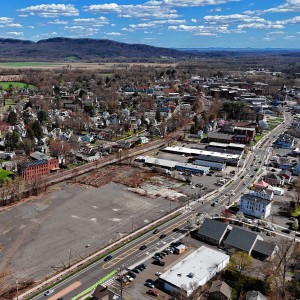 Northampton bans auto dealerships near downtown; zone change won’t affect Volvo operation on King Street
Northampton bans auto dealerships near downtown; zone change won’t affect Volvo operation on King Street
 Proposed Hatfield pickleball/tennis building raising eyebrows
Proposed Hatfield pickleball/tennis building raising eyebrows
 South Hadley man killed in I-91 crash
South Hadley man killed in I-91 crash
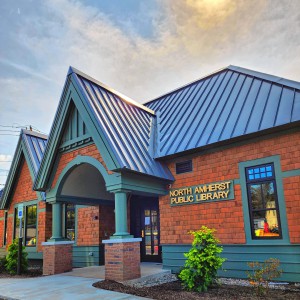 ‘Home away from home’: North Amherst Library officially dedicated, as anonymous donor of $1.7M revealed
‘Home away from home’: North Amherst Library officially dedicated, as anonymous donor of $1.7M revealed
 Police respond to alcohol-fueled incidents in Amherst
Police respond to alcohol-fueled incidents in Amherst
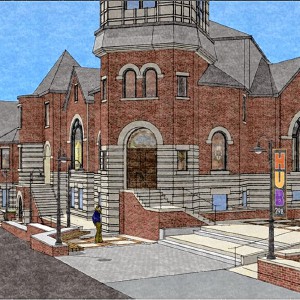 Public gets a look at progress on Northampton Resilience Hub
Public gets a look at progress on Northampton Resilience Hub
Warren Leon, executive director at the Clean Energy States Alliance, said Mass Save’s model is typical across the U.S., while models like Efficiency Vermont’s are less common.
But the structure of the programs themselves is not the only aspect of energy efficiency programs that differs across states. Leon said states also vary in how heavily they fund and prioritize their energy efficiency programs. In this area, he said, Massachusetts stands out.
“Massachusetts has tended to put more funding into energy efficiency than most other states and has implemented energy efficiency more aggressively than most other states,” Leon said.
This level of investment means Massachusetts has done “more of the easy things,” like switching to LED lighting, than some other states have.
“Now, Massachusetts is in the position that to continue to make progress, it needs to tackle some of the more difficult things,” he said.
Mass Save primarily falls short in terms of alignment with the state’s goals for building decarbonization, the report states. The program plans in three-year periods, which the report states “do not reflect long-term decarbonization planning.”
Within Mass Save’s incentive pathways for the commercial and industrial sector, the prescriptive pathway has been developed to be effective for simpler, “cookie cutter” projects like lighting, said Yve Torrie, director of climate, energy and resilience at A Better City, a business-backed group focusing on enhancing Greater Boston’s economic health, competitiveness, equitable growth, sustainability and quality of life.
“What we have been pushing recently is that the custom incentive C&I pathway for more complex projects, like [heating, ventilation and air conditioning] upgrades or changes, be streamlined so these projects can be approved far more quickly, which will allow for the largest GHG emissions reductions within large buildings,” Torrie said.
Leon said one promising technology in the HVAC sphere is air-source heat pumps, which can provide a home with heat energy up to three times the amount of electrical energy it consumes, according to energy.gov. Leon said New England stands to benefit most from these heat pumps in terms of decarbonization — and in terms of saving consumers money.
“In Massachusetts, there are many homes that still use fuel oil, and there are quite a few homes that have older electric heat systems,” Leon said. “And that’s a good opportunity to take advantage of.”
But making changes to HVAC systems requires deep, systematic change, and there’s no one-size-fits-all approach.
“You can’t just go into the building and a couple of hours switch out the heating system,” he said.
Hoffer’s report suggests Mass Save may not be equipped to handle “deep enough retrofits,” and expresses concern about issues unrelated to its capacity to handle increasingly pressing decarbonization efforts.
“As well, there are inefficiencies in the collaborative decision-making, staffing, and leadership structure,” the report states.
Smith said Efficiency Vermont’s structure has been one of its most important successes, and this may have been something that stood out to Hoffer. The infrastructure and layout of programs at Efficiency Vermont allows leaders across multiple industries to “pull together in the same direction” to reach their efficiency and decarbonization goals, he said.
“The thing that makes Efficiency Vermont special is this development of infrastructure for so many different programs that communicate up and down the chain,” Smith said.
Hoffer has previously worked at the Environmental Protection Agency and served as chief of the energy and environment bureau under then-Attorney General Maura Healey. Smith said Hoffer’s level of expertise makes her nod to Efficiency Vermont especially meaningful.
“It feels good to see people ... point to that work as successful and something to emulate,” Smith said. “When those experts say that, it’s really worth paying attention to, because they really understand the nuances of the programs that they’re trying to operate.”
As states like Massachusetts move toward their decarbonization goals, continually looking to other states’ models to find areas to improve is a common and logical practice.
“It is always a good idea to be looking to other states and programs to see what we could be doing better,” Torrie said. “The goal is [greenhouse gas] reduction and if others have programs that are working even more effectively, then let’s see what we can learn from them.”
Stella Tannenbaum writes from the Boston University Statehouse Program.

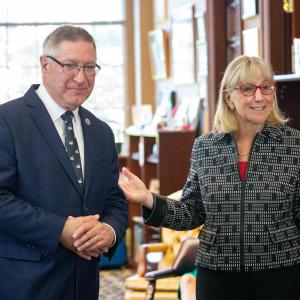 State Senate budget funds free community college for all
State Senate budget funds free community college for all ‘We can just be who we are’: Thousands show support for LGBTQ community at Hampshire Pride
‘We can just be who we are’: Thousands show support for LGBTQ community at Hampshire Pride Doors open at Tilton Library’s temporary home at South Deerfield Congregational Church
Doors open at Tilton Library’s temporary home at South Deerfield Congregational Church Area property deed transfers, May 2
Area property deed transfers, May 2
